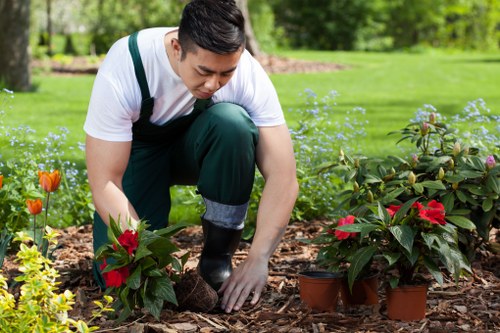Hedge Trimming in Brompton: Expert Tips and Services
Introduction to Hedge Trimming

Maintaining a pristine garden involves various tasks, but one of the most crucial is hedge trimming. In Brompton, where gardens are cherished and aesthetic appeal is paramount, regular hedge maintenance ensures that your outdoor space remains orderly and visually appealing.
Hedge trimming not only enhances the beauty of your garden but also promotes the health and longevity of your shrubs. Whether you are a gardening enthusiast or a busy homeowner, understanding the essentials of hedge care can make a significant difference in the overall appearance of your property.
In this comprehensive guide, we will delve into the importance of hedge trimming, the best times to trim your hedges, the tools you'll need, and the benefits of hiring professional services in Brompton. Let's embark on a journey to transform your garden into a lush, well-maintained sanctuary.
Importance of Hedge Trimming

Regular hedge trimming is essential for both the health and aesthetics of your shrubs. Trimming helps remove dead or diseased branches, allowing for new growth and preventing the spread of pests and diseases. This practice also maintains the desired shape and size of your hedges, ensuring they complement your garden's overall design.
Moreover, well-trimmed hedges can act as natural barriers, providing privacy and reducing noise pollution. In Brompton, where residential areas are often close-knit, maintaining your hedges can contribute to a peaceful and secluded outdoor environment.
Additionally, hedge maintenance enhances the ventilation around the plants, preventing overcrowding and ensuring that each branch receives adequate sunlight and air circulation. This leads to healthier, more vibrant hedges that can withstand adverse weather conditions and thrive throughout the seasons.
When to Trim Your Hedges

Timing is crucial when it comes to hedge trimming. The best time to trim hedges in Brompton generally falls during late winter or early spring, just before the new growth begins. This period allows the plants to recover and flourish as the warmer months approach.
For evergreen hedges, such as boxwood or yew, a light trim in late spring can help maintain their shape and encourage dense growth. On the other hand, deciduous hedges, like privet or beech, may require trimming after they have finished flowering to avoid cutting off essential blooms.
It's also important to consider the specific needs of each plant species. Some hedges may benefit from multiple light trims throughout the growing season, while others might only need an annual maintenance session. Consulting with a local gardening expert can help determine the optimal trimming schedule for your specific hedges.
Choosing the Right Tools for Hedge Trimming

Selecting the appropriate tools is fundamental to effective hedge trimming. The right equipment not only makes the task easier but also ensures that your hedges are trimmed accurately and safely.
- Pruning Shears: Ideal for small branches and precise cuts.
- Hedge Trimmers: Electric or manual trimmers are perfect for tackling larger bushes and achieving uniform shapes.
- Loppers: These are suitable for thicker branches that pruning shears can't handle.
- Gloves and Safety Gear: Protect your hands and eyes while trimming to prevent injuries.
- Ladders: Necessary for reaching higher sections of tall hedges.
Investing in high-quality tools can significantly improve the efficiency and quality of your hedge maintenance. Regularly maintaining your tools by cleaning and sharpening them extends their lifespan and ensures they perform optimally.
Professional Hedge Trimming Services in Brompton

While DIY hedge trimming is feasible for smaller gardens, larger properties or those with complex hedge structures can benefit from professional services. In Brompton, several landscaping companies specialize in expert hedge trimming, offering tailored solutions to meet your garden's unique needs.
Professional gardeners bring experience and specialized equipment to the table, ensuring that your hedges are trimmed efficiently and to the highest standards. They can also provide valuable advice on hedge health, plant selection, and ongoing maintenance strategies.
Opting for professional shrub trimming services often includes additional benefits such as regular maintenance schedules, ensuring that your hedges remain in top condition year-round. This not only saves you time and effort but also adds consistent value to your property's curb appeal.
DIY Hedge Trimming Tips

For those who prefer a hands-on approach, here are some essential tips for trimming your hedges effectively:
- Plan Your Shape: Decide on the desired shape and size before you start trimming to ensure a consistent and balanced look.
- Use Sharp Tools: Dull tools can damage the plants and lead to uneven cuts. Always keep your trimming tools sharpened.
- Trim in Sections: Work on one section at a time to maintain control and precision.
- Clean Up Debris: Remove all trimmed branches and leaves to prevent the spread of pests and diseases.
- Regular Maintenance: Regularly inspect and trim your hedges to promote healthy growth and maintain their appearance.
Implementing these tips can help you achieve professional-looking results while ensuring the health and vitality of your hedges. Consistent hedge care fosters a thriving garden that stands out in Brompton's vibrant landscape.
Remember, patience and attention to detail are key when it comes to hedge maintenance. Take your time to make precise cuts and regularly assess the progress of your trimming efforts.
Benefits of Regular Hedge Trimming

Engaging in regular hedge trimming offers numerous benefits that extend beyond mere aesthetics:
- Enhanced Appearance: Well-trimmed hedges contribute to a polished and organized garden look.
- Improved Plant Health: Removing dead or damaged branches promotes healthy growth and prevents disease.
- Better Air Circulation: Trimming reduces overcrowding, allowing air to circulate freely and reducing the risk of fungal infections.
- Increased Privacy: Maintaining the thickness and height of hedges can provide greater privacy for your outdoor spaces.
- Weed Control: Regular trimming helps keep weeds at bay, minimizing competition for nutrients and water.
By incorporating regular hedge maintenance into your gardening routine, you ensure that your hedges remain a focal point of your garden, enhancing both its functionality and beauty.
Common Mistakes to Avoid

Avoiding common pitfalls can make your hedge trimming efforts more effective and prevent potential damage to your plants:
- Over-Trimming: Removing too much foliage can stress the plant and stunt its growth.
- Improper Tool Use: Using the wrong tools or incorrect techniques can lead to uneven cuts and harm the hedge.
- Ignoring Plant Health: Trimming hedges that are already diseased can exacerbate health issues.
- Neglecting Safety: Failing to use appropriate safety gear increases the risk of injuries.
- Trimming at the Wrong Time: Cutting hedges during unfavorable seasons can disrupt their growth cycles.
Being mindful of these mistakes and taking proactive steps can ensure successful hedge trimming outcomes, promoting the longevity and vitality of your hedges.
Seasonal Hedge Trimming
Seasonal hedge trimming plays a vital role in maintaining the health and shape of your hedges throughout the year. Each season brings unique challenges and opportunities for your plants:
- Spring: Begin trimming as new growth starts, removing any winter damage and shaping the hedge for the growing season.
- Summer: Perform light maintenance trims to control growth and maintain desired shapes.
- Autumn: Focus on cleaning up fallen leaves and preparing the hedges for winter dormancy.
- Winter: Conduct minimal trimming unless necessary, avoiding excessive cuts that could harm the plants during cold months.
Adapting your hedge care routine to the changing seasons ensures that your hedges remain resilient and continue to enhance your garden's beauty year-round.
Choosing the Right Hedge Plants
Selecting the appropriate hedge plants is fundamental to achieving the desired look and functionality in your garden. In Brompton, several shrub species are popular choices for hedge trimming due to their aesthetic appeal and resilience:
- Boxwood: Known for its dense foliage and versatility in shaping.
- Yew: Offers deep green color and tolerance to heavy trimming.
- Privet: Fast-growing and ideal for creating tall, narrow hedges.
- Beech: Provides attractive brown foliage in the winter months.
- Holly: Features glossy leaves and vibrant red berries, adding seasonal interest.
Understanding the characteristics of each hedge plant helps in making informed decisions that align with your garden's design and maintenance capabilities.
Environmental Benefits of Hedge Trimming
Proper hedge trimming not only benefits your garden but also contributes to the broader environment. Healthy hedges act as natural habitats for various wildlife, supporting biodiversity in urban areas like Brompton.
- Carbon Sequestration: Well-maintained hedges absorb carbon dioxide, aiding in the reduction of greenhouse gases.
- Pollinator Support: Flowering hedges attract bees, butterflies, and other pollinators essential for ecosystem health.
- Erosion Control: Dense hedges stabilize soil, preventing erosion and maintaining land integrity.
- Temperature Regulation: Hedges provide shade and windbreaks, contributing to microclimate regulation around your property.
By prioritizing regular hedge maintenance, you play a part in promoting environmental sustainability and enhancing the ecological balance within your community.
Cost-Effective Hedge Trimming
Investing in regular hedge trimming can be cost-effective in the long run. Proper maintenance reduces the need for extensive repairs or replacement of damaged hedges, saving you money on gardening expenses.
- Prevents Overgrowth: Managing growth limits the amount of labor and resources needed for trimming.
- Enhances Plant Health: Healthy hedges require fewer treatments for pests and diseases.
- Increases Property Value: Well-maintained gardens contribute positively to your property's market value.
- Reduces Replacement Costs: Regular trimming extends the lifespan of your hedges, delaying the need for new plantings.
By adopting a consistent hedge trimming routine, you ensure the longevity and vitality of your garden without incurring excessive costs.
Hiring the Right Hedge Trimming Service
When selecting a professional hedge trimming service in Brompton, consider the following factors to ensure quality and reliability:
- Experience: Look for companies with a proven track record in hedge maintenance and landscaping.
- Credentials: Verify certifications and affiliations with local gardening or landscaping associations.
- Customer Reviews: Seek feedback from previous clients to gauge service satisfaction and reliability.
- Service Range: Ensure the company offers the specific hedge trimming and maintenance services you require.
- Pricing: Compare quotes from multiple providers to find a service that fits your budget without compromising quality.
Choosing the right hedge trimming experts ensures that your garden receives the care and attention it deserves, resulting in healthy and beautifully maintained hedges.
Eco-Friendly Hedge Trimming Practices
Embracing eco-friendly practices in hedge trimming not only benefits your garden but also contributes to environmental sustainability:
- Use Sustainable Tools: Opt for electric or manually-operated trimming tools to reduce carbon emissions.
- Recycle Green Waste: Compost the trimmed branches and leaves to create nutrient-rich soil for your garden.
- Natural Fertilizers: Utilize organic fertilizers to nourish your hedges without harming the environment.
- Water Conservation: Implement efficient watering systems to ensure your hedges receive adequate moisture without wastage.
- Integrated Pest Management: Use natural pest control methods to protect your hedges from harmful insects.
Incorporating these sustainable practices into your hedge maintenance routine encourages a healthier garden ecosystem and reduces your environmental footprint.
Advanced Hedge Trimming Techniques
For those seeking to elevate their hedge trimming practices, advanced techniques can offer enhanced precision and aesthetic appeal:
- Layered Trimming: Creating layers within the hedge adds depth and dimension to your garden.
- Topiary: Shaping hedges into artistic forms, such as spirals or geometric patterns, for a sophisticated look.
- Scalloping: Cutting the hedge in a wavy pattern to soften its appearance and blend seamlessly with the surroundings.
- Corseted Trimming: Formal trimming technique that emphasizes a specific shape, such as square or rectangular forms.
- Asymmetrical Trimming: Creating a natural, flowing shape that follows the landscape's contours.
Mastering these advanced trimming techniques can transform your hedges into striking garden features, enhancing the overall charm and elegance of your outdoor space.
Maintaining Hedge Trimming Tools
Proper maintenance of your hedge trimming tools ensures their longevity and effectiveness. Regular upkeep includes:
- Cleaning: Remove debris, sap, and dirt from tools after each use to prevent rust and corrosion.
- Sharpening: Keep cutting edges sharp to ensure clean, precise cuts and reduce plant stress.
- Lubricating: Apply oil to moving parts to maintain smooth operation and prevent wear.
- Storage: Store tools in a dry, protected area to avoid damage from the elements.
- Inspection: Regularly check for any signs of damage or wear and replace parts as needed.
By maintaining your hedge trimming equipment, you not only extend their lifespan but also enhance the quality of your hedge maintenance efforts.
Seasonal Challenges in Hedge Trimming

Each season presents unique challenges for hedge trimming, requiring adjustments in your maintenance approach:
- Spring: Managing rapid growth and preventing overgrowth as plants emerge from dormancy.
- Summer: Dealing with heat stress and ensuring adequate hydration during trimming.
- Autumn: Handling fallen leaves and preparing hedges for winter protection.
- Winter: Navigating harsh weather conditions and minimizing trimming activities to prevent plant damage.
Understanding and adapting to these seasonal factors ensures that your hedges remain healthy and resilient throughout the year, regardless of environmental conditions.
Integrating Hedge Trimming with Overall Garden Care

Effective hedge trimming should be part of a holistic garden care strategy. Integrating trimming with other gardening practices enhances the overall health and beauty of your outdoor space:
- Soil Health: Regularly test and amend soil to provide essential nutrients for your hedges.
- Watering: Implement consistent watering schedules to maintain optimal moisture levels.
- Fertilization: Use appropriate fertilizers to support robust hedge growth.
- Pest Control: Monitor for pests and diseases, addressing issues promptly to protect your hedges.
- Mulching: Apply mulch around hedge bases to conserve moisture and regulate soil temperature.
By combining hedge trimming with these essential gardening practices, you create a synergistic environment that fosters healthy, vibrant hedges and a flourishing garden.
Customizing Your Hedge Trimming Approach
Every garden is unique, and so should be your hedge trimming approach. Customizing your trimming strategy involves considering factors such as hedge type, garden layout, and personal aesthetic preferences:
- Hedge Type: Different shrubs require specific trimming techniques and frequencies for optimal growth.
- Garden Layout: The positioning of your hedges within the garden influences their shape and size.
- Aesthetic Preferences: Choose trimming styles that align with your desired garden theme, whether formal, natural, or contemporary.
- Functionality: Consider the role of your hedges, such as providing privacy, acting as windbreaks, or serving as decorative elements.
By tailoring your hedge maintenance activities to your garden's specific needs and your personal taste, you achieve a harmonious and well-coordinated outdoor space that reflects your style and preferences.
Final Thoughts on Hedge Trimming in Brompton
Effective hedge trimming is a blend of art and science, requiring knowledge, skill, and dedication. In Brompton, where gardens are a source of pride and joy, maintaining your hedges is essential for creating a beautiful and healthy outdoor environment.
Whether you choose to undertake hedge trimming yourself or enlist the expertise of professional services, prioritizing regular maintenance ensures that your hedges remain vibrant, structured, and full of life. Embrace the practices and tips outlined in this guide to elevate your gardening efforts and enjoy a flourishing, picturesque garden all year round.
Ready to transform your garden? Contact us today to schedule your professional hedge trimming service in Brompton and experience the difference expert care can make.